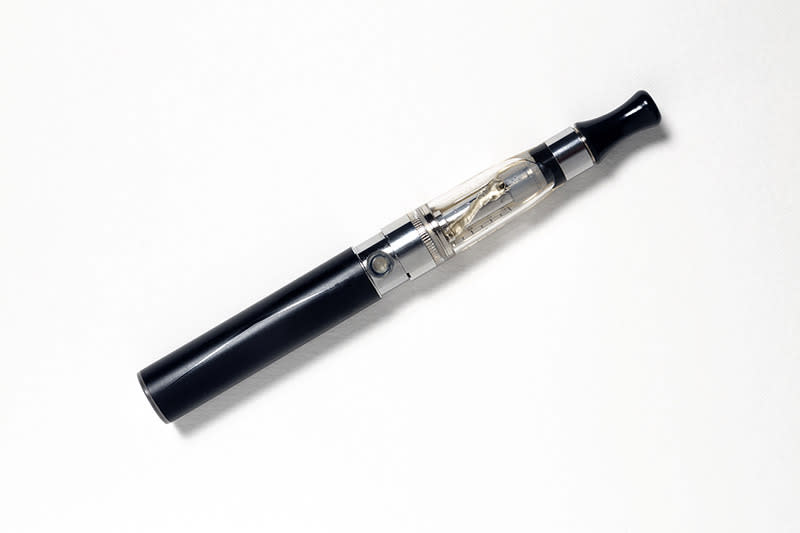E-Cigarette Flavorings Linked to Lung Diseases

E-cigs might not be as harmless as originally thought. (Getty Images)
Originally touted as a harmless alternative to traditional cigarettes, more research has started to suggest that e-cigarettes may not be so safe after all.
The latest study published in the journal Environmental Health Perspectives specifically examined the chemicals that make up the flavoring in leading e-cig brands, and found that most contain at least one questionable flavoring chemical. Over half contain diacetyl, a chemical that has been associated with severe lung disease.
For the study, researchers at Harvard University chose 51 types of flavored e-cigarettes sold by leading brands. They purposefully chose flavors that seemed most appealing to youth, including a variety of fruit, candy, and cocktail flavors.
By analyzing the air stream of each e-cigarette, they found three questionable flavoring chemicals: diacetyl, pentanedione, and acetoin. Only four out of all 51 samples contained no flavoring chemicals.
Related: Your Body Immediately After Vaping an E-Cigarette
Diacetyl is the most concerning of the three, having been linked to severe respiratory diseases such as bronchiolitis obliterans. This severely obstructive (and irreversible) lung disease is more commonly known as “popcorn lung,” due to a high incidence in former workers of microwave popcorn plants.
“Studies have shown that workers in microwave popcorn manufacturing plants have documented relationships between cumulative exposure to diacetyl vapor over time and having abnormal lung function,’ explains Leslie J. Kohman, Medical Director of Upstate Cancer Center, Director of Thoracic Oncology Program, and Medical Director of Lung Cancer Screening Program at SUNY Upstate Medical University.
A 2000 investigation into a plant in Missouri led to intensive research, and The National Institute for Occupational Safety and Health (NIOSH) put out an alert, Preventing Lung Disease in Workers Who Use or Make Other flavorings like pntanedione and acetoin have been shown to cause similar damage.
While this Harvard study proves all three chemicals are present in e-cigarettes, the exact harm in vaping them for a specific period of time, and at this specific level, is still unknown. But Kohman notes that the amounts in e-cigarettes are considerably higher than the parts-per-million safe limits recommended by OSHA. “In addition, the exposures to workers are limited to a 40-hour work week, and distributed across a work day, while in e-cigarette users, the concentration is much higher during the time they are actively vaping.”
Related: Teenagers Use E-Cigarettes to Vape Marijuana, Study Says
The American Lung Association (ALA) notes that flavoring ingredients in e-cigarettes are FEMA GRAS, “generally recognized as safe,” by the FDA. But that status only refers to food–they’ve never been recognized as safe for inhalation.
So how worried should you really be? “The evidence is strong enough that the Occupational Safety and Health Agency (OSHA) has recommended the following warning on any compounded flavors containing (these substances) if the compound will be heated during processing: ‘Warning: ……Handling of this flavor that results in the inhalation of fumes, especially if the flavor is heated, may cause severe adverse health effects,’” Kohman says,
Yes, cigarettes contain diacetyl, too (probably in much higher amounts). “However, there are other causes of lung disease caused by smoking cigarettes, and emphysema and related diseases are far more common than ‘popcorn lung’ in cigarette smokers,” Kohman notes.
Besides the questionable chemicals, both Kohman and the ALA note that flavorings, like the ones studied here, target young people, drawing them into vaping.
Related: Pregnant Women May Be Unaware of Possible E-Cigarette Risks
Another recent study from the UC San Diego School of Medicine found that smoking e-cigarettes may actually make it harder for smokers to quit; and a previous study from 2013 found they impede lung function with short-term use in a similar way as normal cigarettes.
“E-cigarettes have never been shown to be safe,” Kohman says, “and this information supports the position that they can cause significant health problems.” Since their content is not regulated, they may even contain more harmful substances we don’t know about. “So this is just more evidence that e-cigarettes should be regulated as an unsafe tobacco product and avoided by consumers, especially children.”
The researchers recommend urgent action to evaluate these chemicals further and what widespread, daily exposure via e-cigarettes will mean for users.
Read This Next: Taking This for the Flu Doesn’t Work
Let’s keep in touch! Follow Yahoo Health on Facebook, Twitter, Instagram, and Pinterest.

